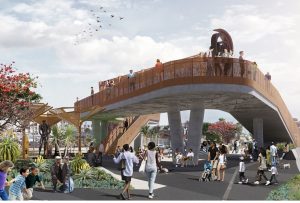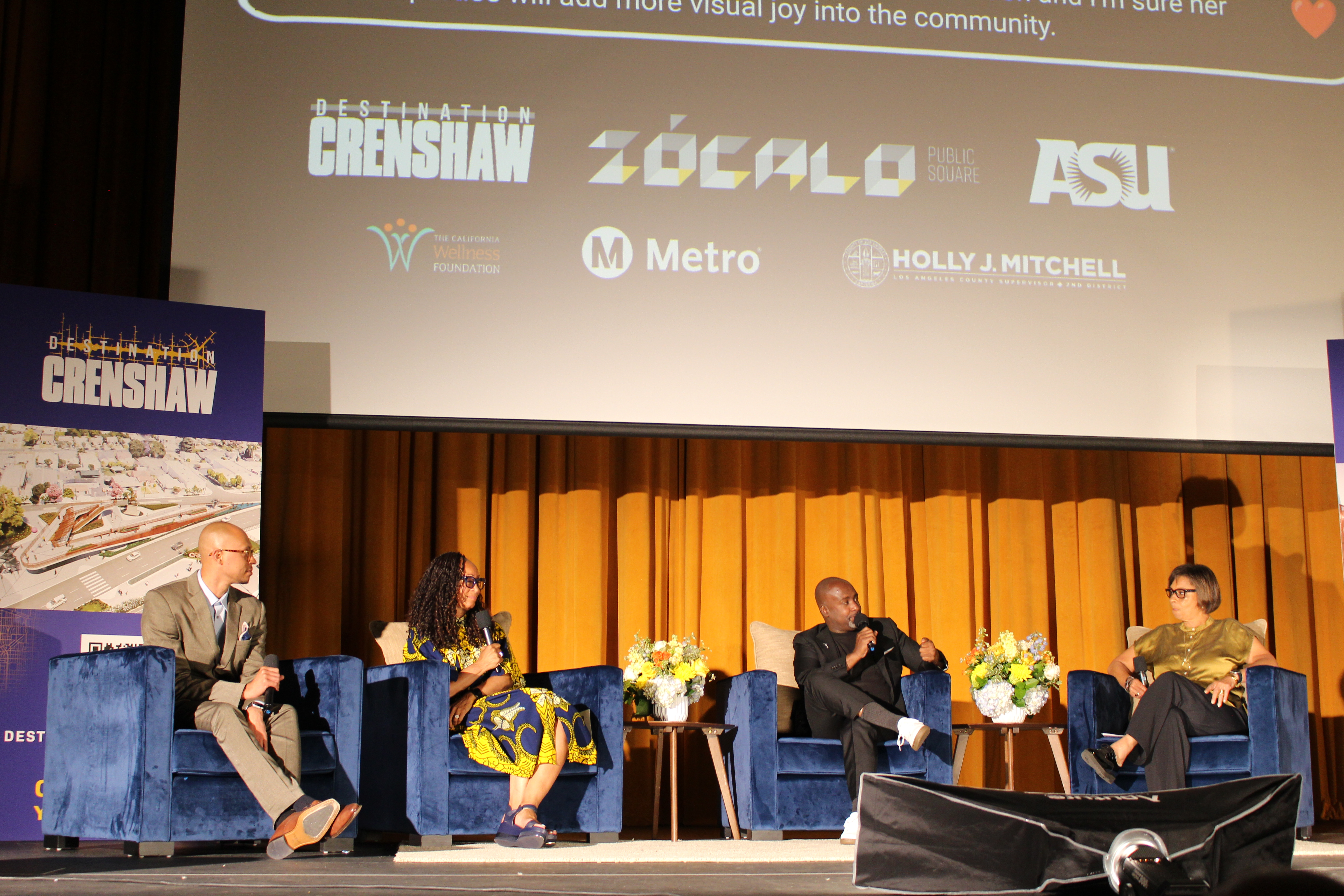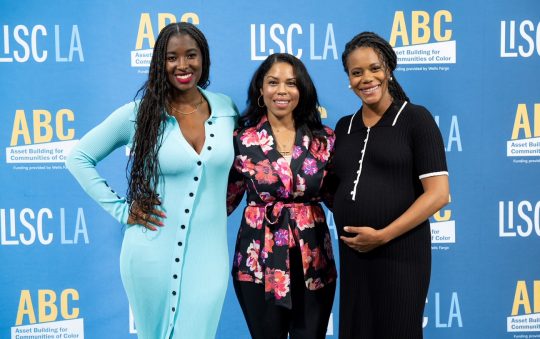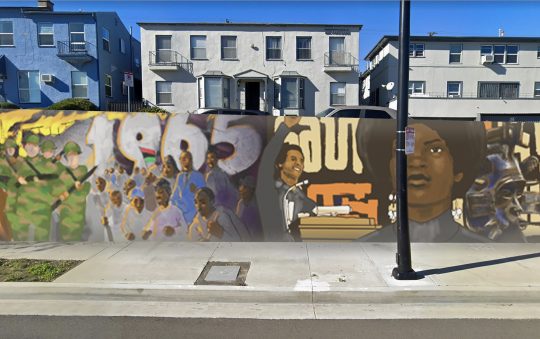
Destination Crenshaw is shaping up to be the nation’s largest outdoor art and cultural celebration of Black contributions The highly anticipated reparative development project continues to collaborate with local leaders and talented professionals to ensure input from the community is valued and embraced from ideation to completion.
L.A. City Council President Pro Tempore Marqueece Harris-Dawson joined Gabrielle Bullock, principal and director of Global Diversity at Perkins & Will; and Dr. V. Joy Simmons, Destination Crenshaw senior art and exhibition advisor for an in-depth conversation discussing the future 1.3-mile public art open-air museum.
The project will transform Crenshaw Boulevard from an area that has long deserved economic investment and strategic urban planning into a thriving commercial corridor linked by architecturally stunning community spaces and pocket parks with hundreds of newly planted trees.
“We believe strongly as a community organizer; people will always oppose what you do to them. They will disregard what you do for them, and they will only embrace what you do with them, stated Harris-Dawson.
“We hit the streets in a big way, knocked on more than a thousand doors. We took almost 500 surveys, talked, convened with business owners, faith leaders and connected with people who are engaged in the conversation and can participate in the project.”

Also, the architectural firm Perkins and Will, which is also known for its design of the Smithsonian National Museum of African American History and Culture in Washington DC, has a profound history of creating spaces that tell the stories of communities.
Residents in attendance and those tuned in online were introduced to the curatorial process for incoming sculptures, murals, and architecture through video presentations along with renderings displayed throughout the event space.
The theme of the program posed a question: “How do you grow a rose from concrete?” inspired from the poem by Tupac Shakur. The poem is a metaphor for resilience and determination. It compares the cracked concrete of an urban environment to the challenges faced by marginalized individuals. The rose represents hope and beauty emerging from adversity, defying limitations, and societal expectations.
Initially, the plan for a new Metro line called for the train to cut through the heart of South Los Angeles without stopping at its most notable cultural and economic hub. Historically, infrastructure projects in Los Angeles have ruined urban neighborhoods without taking local input into account. In 1963, the I-10 highway tore through the area and in 2011, the city chopped down 119 trees to make a path for the space shuttle Endeavour.
Destination Crenshaw produced the event with Zócalo Public Square which noted the proactive response of local voices for inclusivity regarding the Metro K Line. Area leaders convinced the city not only to add a Metro stop in their community but to leverage its construction into the creation.
When complete, Destination Crenshaw will be home to artworks by Los Angeles artists like Charles Dickson, Maren Hassinger, Alison Saar, and Kehinde Wiley. Its architecture, streetscapes, and landscape designs are firmly rooted in Black identity, from native giant star grass to Sankofa Park’s namesake bird, which represents the need to look to the past to build the future.
The project is commissioning more than 100 Black Los Angeles artists of various media, including illustration, performance, and culturally stamped infrastructure for permanent and temporary installations in the corridor. As California’s largest Black artists jobs program, the value of this program will provide additional access to resources, mentorship, and professional development opportunities for participating artists creating a pipeline of work for emerging, seasoned and internationally renowned artists.
Gabrielle Bullock, an award-winning architect in Perkins and Will’s Los Angeles office, is regularly sought out around the world for her leadership and expertise in issues of social and racial equity in architecture. Aside from project design, she also oversees Perkins and Will’s Diversity, Inclusion, and Engagement program, which works to support and strengthen a firmwide culture that embraces a diversity of people, colors, creeds, credos, talents, thoughts, and ideas.
Her unique role as a principal and the firm’s Director of Global Diversity enables her focus on building types that require sensitivity to their social context and uniquely complex.
“Most Black architects want to impact the communities where they live, the neighborhoods and the places that shape us,” she explained to the audience.
“I’ve devoted my entire career to doing just that. This project is clearly the perfect example of it. I wanted to improve the way my people lived. For me, this project is a gift. It gives me great pride and I’m honored to be a part of this.”
The program was also presented in partnership with generous support from Akieva and Martin Jacobs. Crenshaw High School Principal Donald Moorer was in attendance to welcome panelists on the Zócalo stage with Destination Crenshaw President Jason Foster also chiming in on the economic impact.
“The two zip codes of Destination Crenshaw is 90008 and 90043. There is $323 million of gross revenue in our creative economy currently happening today. We are making sure there’s a permanent place to be able to access and grow that in our community,” Foster said.
“We’re going to be the first stop on the train once it’s connected to the airport. The opportunity for us to take advantage of that and showcase who we are is what will really make a difference.” He also pointed to union jobs and higher wages as a benefit along with an increase in property and land value.
The event concluded with Q&A from in-person guests and through an online chat. Many felt a sigh of relief when Harris-Dawson guaranteed the spirit of Nipsey Hussle who named the master plan would be recognized for his legacy by continuous communication with his surviving family members.
Destination Crenshaw is expected to be completed Fall 2024. The first of the murals will be displayed in May with more art installations slated throughout the summer. Permanent art has been installed and the public gathering spaces are completed.
The unveiling, expected in November will include the inauguration of Sankofa Park at the north end of the Destination Crenshaw corridor. A large-scale community celebration will take place after which Destination Crenshaw will officially be open for public use.







